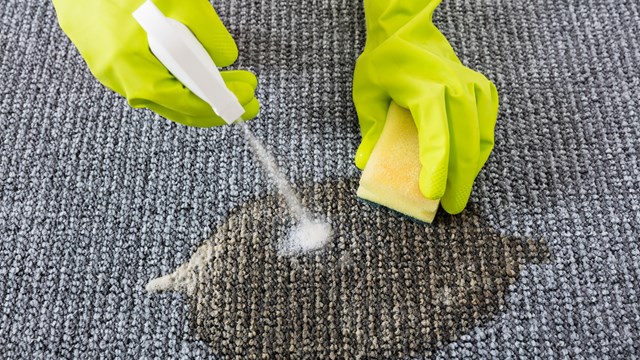
In New York City, people spend a lot of time looking around. Tourists gaze at the skyscrapers, fashionistas window-shop and traders peruse the markets. But not much thought is probably given to our homes and the floors beneath our feet.
To find out about the latest trends and technical developments in flooring, we spoke to some experts and took a good long look at the options available for the floors in your building common areas.
Who's the Floor For?
When considering replacement and installation of new flooring in common areas, the condo or co-op board should start with questions. How much traffic does the area get, and what kind of foot traffic? Are these floors mostly walked upon by residents, maintenance staff, or both? Do any safety or special precautions need to be made (consider elderly residents, children/strollers, animals)? How much can you spend now, and how much can you afford on any necessary upkeep or cleaning? Does it need to help absorb sound in high traffic areas?
There are many people who need to be involved in the process of answering these questions, and for good reason. Not only is the flooring in common areas there for the treading pleasure of a building’s residents, it is also a reflection of the building to visitors and potential buyers. A prospective owner looking at numerous real estate candidates might have their final decision come down to how much they hate the battered linoleum in the hallways of a property or how much they love the bold, graphic carpet in the lobby. “I think overall, hallway and lobby renovations have a direct impact on the value of the apartment, the time it takes to sell an apartment and the overall curb appeal of the building,” says Jeanette Hubley, principal designer of Manhattan-based Hubley Design Interiors, LLC.
The voices that should be involved in the flooring replacement conversation should include the budget and finance committee of a building’s board, who can decide how much a building can afford to spend and how they will spend it. Additionally, members of the board should work together to select the design and renovation company best suited for the job. Depending on the size of your building, you might even consider “auditioning” different swatches or tile samples in an inconspicuous spot in your lobby to gauge public opinion. Though, make sure residents know that ultimately, the board will make the decision or you could find yourself if a month-long battle of porcelain versus granite.
Not only do you want the flooring to be safe and efficient, you also want to it match the style of your building and its residents. If your property is sleek and modern, shag carpet might not be the best fit.
Charlotte Barnard, creative director at Nemo Tile Company also recommends that boards ask themselves of their flooring, “Will you be able to seal it when necessary? Is it a new or trendy product such that if it’s discontinued or a portion is damaged, it can’t be replaced or repaired quickly and easily?”
Fashion Plus Function
Thinking short term and long term are the name of the game when tackling this project, which means the board should consider both the most commonly installed materials in hallways and lobbies as well as some of the newer trends.
According to Barnard, porcelain and marble some of the most commonly-installed flooring materials in New York multifamily buildings.
Marilyn Sygrove, president of Sygrove Associates Design Group, Inc. in Manhattan, agrees, adding, “In terms of the lobby, depending on the location of the building and the population, a building that can afford more maintenance will typically go with a real stone material—most often a marble because there is so much variety in marble. Historically, prewar buildings are all done in marble. Granite was used in the 1970s and 1980s as sort of a trend, and if it's a polished granite it is difficult to maintain, so you see that less and less, unless it's a honed finish,” she says.
“Today,” Sygrove continues, “the porcelain tile industry has made such tremendous strides in the variety of tile colors, finishes—just amazing variety—and many of the porcelain tiles replicate real stone and marble.”
In new construction condo and co-op buildings, the route of durability and ease of maintenance seems to be a priority for boards. Additionally, Barnard says she has noticed a texture trend. “You can find a great selection among porcelains that have a textured look and surface to replicate textiles and wallpaper, as well as porcelain that imitates stone and wood—including different species of wood, and wood that looks weathered or petrified. Porcelain can be far more durable than stone, easier to match over a large area, and it doesn’t stain or show imperfections. It’s easier to maintain, too.”
On the Carpet
Carpeting is typically the first choice of flooring for building hallways because of its soundproofing quality, luxurious look and low maintenance upkeep.
“As far as carpeting, what we're seeing a lot of now is solution-dyed nylon carpet,” Hubley says. “It increases the longevity and look of the carpet, because it is resistant to pet stains and chemicals such as bleach.”
Hubley has seen some flooring missteps, both in form and function. Of the flooring mistakes that she has seen, inappropriate carpeting is a recurring issue. “With carpets, nylons and wools are the best products to use. A loop construction carpet could be a problem,” Hubley warns. “When people are moving in and out of their buildings, the loop could catch and the carpet could get ruined.”
Barnard adds that “Not seeing a large piece of flooring material before buying” is a big misstep. “You want to see the complete spectrum of what material will look like. A very large piece will show you if it is marbleized, for instance, or if it has a lot of veining.” Similarly, consider (like you would when choosing a paint color) how different a small sample of tile looks compared to a full floor made out of that tile. Beware: Patterns and details that seemed interesting on a 5-x-5 tile might be overwhelming when it’s wall-to-wall.
That shouldn’t scare you away from going bold, however. Barnard says that an unusual or unexpected flooring option to consider is large-scale porcelain tile, “Four feet by two feet and 60 inches by 30 inches that can be utilized for heavy-duty commercial applications. Large-format tile will not make a small space look smaller; quite the contrary.”
When shopping around these various styles, keep in mind how much you’d like your elevators or stairs to stand out. Do you want the lobby flooring to continue into the elevator and common areas on all floors? Should the style remain consistent throughout the building?
When Price is an Object
If your main concern is coming in under budget, Sygrove and Hubley suggest commercial-grade nylon carpet. Sygrove points out that porcelain is very budget friendly as well. On the opposite end of the budget, wool carpet is among the priciest flooring materials.
While it is tempting for budget-conscious buildings to settle on cheaper flooring options, skimping on quality can cost you in the long run, Sygrove warns. “Nylon carpet is not much less than a wool carpet,” she says. “They both require the same amount of maintenance. It's a matter of wear-and-tear and what's going to look better longer. “We've done wool blend carpets that are down for 15 to 20 years and they look brand new. It may have been more expensive upfront, but with proper maintenance, it has a very, very long life span. You put down an inexpensive loop nylon carpet that gets matted down in the first six months to a year and it looks terrible. It may not wear out, but it's going to ugly out a lot quicker. These are dollar-and-cents as well as performance issues that a board should be educated towards for them to make a decision,” Sygrove says.
Regardless of how much you spend, you’ll want to get the most life of the flooring you choose.
Hubley recommends vacuuming carpeting daily and deep cleaning monthly, avoiding the use of extractors. Barnard adds that you should “sweep daily, mop weekly; fine grit can be very damaging. And follow the manufacturer’s instructions and use the products they recommend, especially for installation.”
Cutting corners or skipping maintenance will take years off the life of your flooring—even if you get the crème de la crème of Italian marble tile and spare no expense, that doesn’t mean it doesn’t need as much attention as simple, inexpensive carpet. Beyond regular cleanings, consider a professional cleaning at least twice a year for carpeting, polishing every two years for wood, tile, granite and marble flooring.
We don’t necessarily give that much thought to the ground beneath our feet, but when the flooring stands out as clean, well-cared for and thoughtfully chosen, your residents will take pride in the first impression your building gives its visitors.
Rebecca Fons is a freelance writer and a frequent contributor to The Cooperator. Editorial Assistant Enjolie Esteve contributed to this article.






Leave a Comment